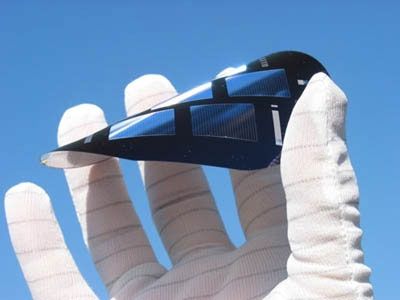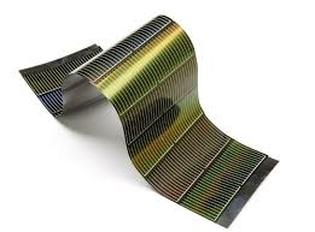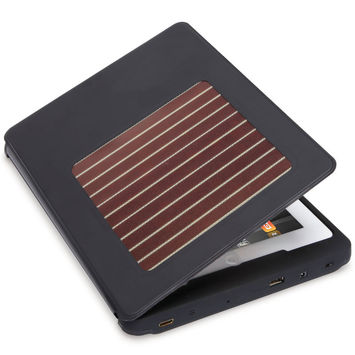|
The fashion industry, just like any industry, is attempting to merge with technology at a fast rate. This combination has to be extremely functional, subtle and be something the consumer would potentially need in his/her daily life- that is simply what good design is all about, right? The most common commingling of fashion and technology we've seen in recent years is various methods for charging your electronic devices, such as your tablet, smartphone, gaming systems directly from your clothing, without the extra need to carry cables or portable chargers with you. How do you do that? Using solar panels. Sounds like a great idea right? So why doesn't every jacket, dress and blouse have this useful technology installed already and why haven't we seen these items invade the market yet? The answer to this complex design problem is simple, and we'll go into some detail explaining why we think so bellow: 1. It Is Expensive It really comes down to the price point. When you weigh the dollar amount to the need for the product it becomes not-worth-it to the consumer. In other words, as much as I like the concept, why would I spend over $500 for a regular clothing item that charges my phone when I can get a portable charger for $8 at the drug store. Yes, it will take some extra effort on my part to charge the device but it is a smarter purchase when you think about the odds of your phone loosing battery. In addition, there is huge competition with Apple's Iphone and other devices that have already introduced a Battery Save mode which works pretty well in maintaining your smartphone's battery throughout the day, minimizing the need for outside charging devices- and, it's technically free! There is definitely a pricing issue with technology infused apparel and it is not the product designer's fault either- It's nobody's fault really. the problem is that we can't get discreet, solar panels at a reasonable wholesale cost yet, and the manufacturing cost of these clothing items is through the roof. By the time it gets to the consumer, the cost has tripled and many people cannot afford the luxury of purchasing an item as such. 2. It is not aesthetically and functionally easy to wear yet If we're going to spend a lot on techno-apparel we want it to offer top-notch comfort and make us "look good" for lack of a better term. The fact that clothing should increase our confidence and be flattering will always be a reality as long as we remain human. This factor has proven to be true throughout history, it is today, and will be for as long as we wear clothing. The issue with solar panel clothing at the moment is that the need for larger panels creates a bulky, almost overly-futuristic look the average consumer is not yet comfortable wearing. We simply don't have the right developments to incorporate solar panel technology into apparel in a discreet, extremely functional way. For example, if we had access to a small chip technology that used solar energy to build enough power for charging our devices fully, and this chip technology would come at a reasonable cost, we would most likely see this used very often across the market. We are simply not there yet. Instead, we have to settle for the use of a larger solar panel surface in order to achieve full charge. As a result, we have to settle for heavier, bulkier, and less comfortable clothing. 3. Other industries can offer a more affordable, reachable solution We mentioned the Battery Save mode on your smartphone as a solution for fixing the battery problem. This comes at an all-inclusive cost to the smartphone user, and in fact, works pretty well. There are also simple solar charging tablet and smartphone cases that also come at a reasonable cost and can actually get rid of the need to ever charge your phone by cable. Unfortunately for the solar apparel industry, the probability that these will be the norm for charging our devices in the near future is very high- the clothing industry simply cannot compete. It is very likely that unless tech science comes up with a very subtle but powerful solar charging method that can be incorporated into apparel at a low cost, the idea of charging your devices with your clothing is slowly going to be overtaken by other industries. That is not to say that the apparel industry can't bounce back with advancements in product design and customer satisfaction. In fact, the clothing industry can simplify and solve problems in the consumer's life by more mechanical means. For example, a good convertible clothing item that is comfortable and wearable can sometimes be a simple answer to a complex problem. Every industry has its own strengths and weakness, but the apparel industry will always have an upper hand in the art of textile use. Check out the 11:11 Convertible Jacket, a jacket that transforms from jacket to shoulder bag.
0 Comments
Leave a Reply. |
The Blog:A journey into our design process, sewing tutorials, fashion tips, and all the inspiring people and things we love. Doina AlexeiDesigner by trade and dressmaker at heart. I spend most of my days obsessing over new fabrics and daydreaming new ideas. Sadie
Executive Assistant & Client Relations Manager Archives
November 2019
Categories
All
|
-
Sewing Tutorials
-
Basics
>
- Aligning Pattern Grainlines To Fabric
- Preparing Fabrics For Sewing
- Pinning Sewing Patterns To Fabric
- Placing Sewing Patterns On Fabric For Cutting
- Rotary Cutters or Fabric Scissors?
- Cutting The Sewing Patterns
- What Are Notches And How To Use Them In The Sewing Process
- Transferring Notches From Pattern To Fabric
- Transferring Seamlines to Fabric
- Staystitching
- Backstitching: A Complete Guide
- Hand Basting: A Complete Guide
- Sewing Continuous Bias Binding
- Darts >
-
Sewing Seams
>
- The Basics Of Seams And Seam Allowance
- How To Sew A Straight Seam
- Sewing Curved Seams
- Sewing Corner Seams
- Trimming And Grading Seam Excess
- Notching/Clipping Seam Allowance for Tension Release
- Sewing Topstitched Seams
- Sewing Corded Seams
- Sewing A Slot Seam
- Sewing A Gathered Seam
- Sewing Bias Seams
- Sewing Seams With Ease
- Sewing Seams With Crossing Seamlines
- Sewing Unlike Fabric Seams
- How To Iron Seams: Ironing Tools And Conventions
- Sewing With Knit Fabrics
- Understanding Stitch Length And Tension
- Sewing Unique Fabric Seams
-
Seam Finishes
>
- Seam Finishing Techniques - Overview
- Applying A Pinked Seam Finish
- Applying A Bias Bound Seam Finish
- Serging And Zigzag Seam Finishes
- Sewing A Self-Bound Seam Finish
- Sewing A French Seam Finish
- Sewing A Hong Kong Seam Finish
- Sewing A Mock French Seam Finish
- Sewing A Turned-and-Stitched Seam Finish
- Sewing Overcast Hand-Applied Seam Finishes
- Sewing A Flat Felled Seam
- Sewing A Hairline Seam Finish
-
Hem Finishes
>
- Garment Hem Finishes: Overview
- Sewing A Double Fold Hem Finish
- Sewing A Single Fold Hem Finish
- Sewing Bound Hem Finishes
- Sewing An Exposed Double Layer Bound Hem
- Sewing A Folded-Up Bound Hem with Pre-folded Binding
- Sewing A Hong Kong Hem Finish
- Sewing A Band Hem Finish
- Sewing A Bias Faced Hem Finish
- Sewing A Twill Tape Hem Finish
- Sewing A Rolled Hem Finish
- Sewing A Shaped Hem Facing
- Using Fusible Hem Tape And Webbing
- Finishing A Lace Fabric Hem
- Finishing A Leather Hem
- Sewing Faced Hem Corners
- How To Finish Lining At The Hem
- Finishing Fabric Corners by Mitering >
- Interfacing A Hemline: Lined And Unlined Examples
-
Sewing Pockets
>
- Curved Patch Pocket With Flap
- Unlined Square Patch Pockets
- Lined Patch Pockets: Two Ways
- Extension On-Seam Pockets
- Separate On-Seam Pocket
- Front Hip Pockets
- Bound Double Welt Pocket
- Double Welt Pocket With Flap
- Self-Welt Pocket (Using Single Fabric Layer)
- Slanted Welt Pocket (Hand-Stitched)
- Faced Slash Pockets: Overview >
-
Sewing Zippers
>
- Sewing Zippers: General Information
- Sewing A Centered Zipper
- Sewing A Lapped Zipper
- Sewing An Invisible Zipper
- Sewing A Fly Front Zipper
- Sewing A Closed-End Exposed Zipper (No Seam)
- Sewing An Exposed Separating Zipper
- Sewing Hand Stitched Zipper Applications
- Sewing A Zipper Underlay
- Sewing A Placket-Enclosed Separating Zipper
- Sleeveless Finishes >
-
Neckline Finishes
>
- Sewing A Neck Shaped Facing
- Sewing An All-In-One Neck Facing
- Neck And Garment Opening Combination Facings >
- Sewing A Bias Faced Neckline Finish
- Sewing A Band Neckline Finish
- Bound Neckline Finishes: Overview >
- Sewing A Semi-Stretch Strip Band Neckline
- Ribbed Neck Band And Classic Turtleneck
- Decorative Neckline Finishes >
- Finishing Facing Edges >
-
Extras
>
- A Complete Guide on Interfacing
- Sewing Bound Spaghetti Straps
- Sewing Spaghetti Straps To A Faced Neckline
- Sewing Ruffles: Overview
- Patterning And Sewing A Circle Ruffle
- Sewing A Gathered Heading Ruffle
- Sewing Double Layer Gathered Ruffles
- Sewing A Gathered Ruffle Into A Seam
- Sewing A Gathered Ruffle To A Fabric Edge
- Sewing A Fabric Surface Slit
- Sewing A Slit Seam
- Hand-Applied Straight Stitches
- Hand-Applied Blind Stitches
- Hand-Applied Overedge Stitches
- Hand-Applied Tack Stitches
- Hand-Applied Decorative Stitches
-
Basics
>
- Custom Bridal
- Custom Apparel
- About
- Blog
Services |
Company |
|






 RSS Feed
RSS Feed

